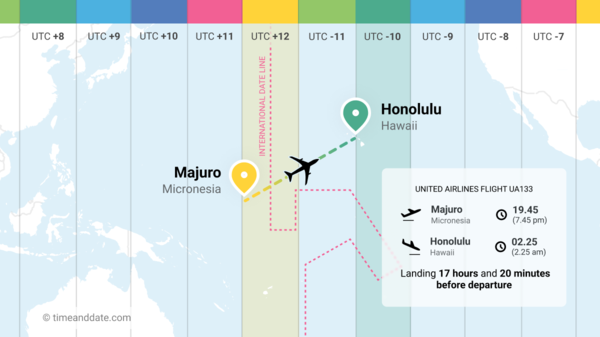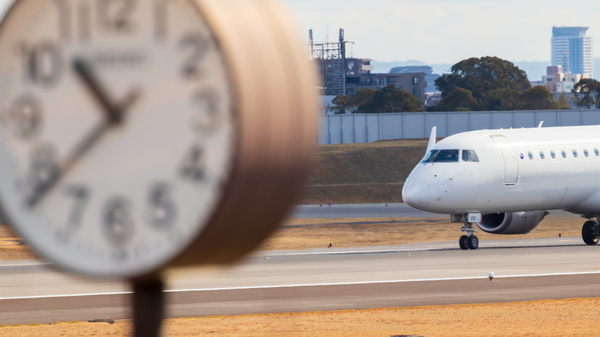Flights That Land Before You Leave
Flying across time zones or the International Date Line can reverse the clock and give you the chance to “relive” part of a day.


A flight from Micronesia to Hawaii can put you on the ground close to a full day before you took off.
©timeanddate.com
Cheating the Clock
Have you ever wished you could have a day back to do over? Real time travel may not exist (yet), but you can board a flight that lets you “regain” some time.
This kind of temporal tourism is made possible by high-speed air travel aross time zones and the effect of crossing the International Date Line (IDL). And it is nothing new. As far back as 1977, you could board a supersonic flight from London at 10.30 am and land in New York at 09.25 am, some 1 hour and 5 minutes before you left, in local time.

Time gains from air travel can range from just a few minutes to almost 24 hours.
©iStockphoto.com/Toru Kimura
Extreme Time Travel
To see a major shift in local time, fly east from an airport close to the International Date Line to a destination just on the other side of that border. Crossing over the IDL headed west means the time changes suddenly to one day later, going east it becomes one day earlier
So imagine you are visiting Micronesia, say Majuro in the Marshall Islands. That green atoll is in the UTC+12 time zone, while Honolulu, Hawaii sits at UTC-10, a 22-hour difference.
Get on board United Airlines flight UA133 for the five-hour trip from Majuro to the Hawaiian capital, and you should land around 17 hours before you took off in local time, “gaining” close to an entire day.
Straddling Whole Years
One day not enough of a bonus? To heighten your sense of time travel even further, try leaving as early as possible on New Year’s Day and fly back through time to the previous year. On January 1, 2023, you could have done just that by making a trip from South Korea to the USA.
According to international air travel site FlightRadar24, United Airlines flight 858 took off from Seoul at 12.29 am January 1, 2023, crossed the International Date Line over the Pacific, and landed in San Francisco International Airport at 5.01 pm on December 31, 2022. The nine hour and 46 minute-long flight created an “extra” seven hours for passengers to celebrate New Year’s Eve a second time.
Quick Hops
Some flights create tiny slices of time gain. A short route in the US from Atlanta, Georgia, to Dothan, Alabama, crosses a time zone boundary and can land four minutes before takeoff.
In Europe, Istanbul airport hosts a number of short time-reversing flights, such as a hop from the Turkish capital to Podgorica in Montenegro that typically lands fifteen minutes before departure.
One of the shortest “arrive before you leave” flights takes wing in Canada. The La Romaine (ZGS) to Natashquan (YNA) flight covers just 50 miles (80km), with a departure time of 12:20 pm to land at 11:35 am, a difference of 45 minutes at certain times of the year.
Time Zones and the Date Line
What makes these quirks in timekeeping possible is your direction, number of time zones crossed, and the effect of the IDL.
Running through the mid-Pacific Ocean, the International Date Line is positioned halfway around the world from the prime meridian (0° longitude), which is centered on Greenwich in the UK. Crossing this imaginary line creates the largest time shift on the planet.
Another factor affecting how much the time may change on a journey is the fact that the number of time zones you cross on a flight varies depending on where you are in the world.
The way these boundaries are structured is not as straightforward as you might expect, given that our globe is divided into 360 even degrees. Instead of a neat apportioning of 24 like-sized areas across the planet, each 15 degrees apart, the official time zone map has been drawn to match internal and international borders, creating irregular-sized zones in many places, and some time zones are only 30 and 45 minutes apart.